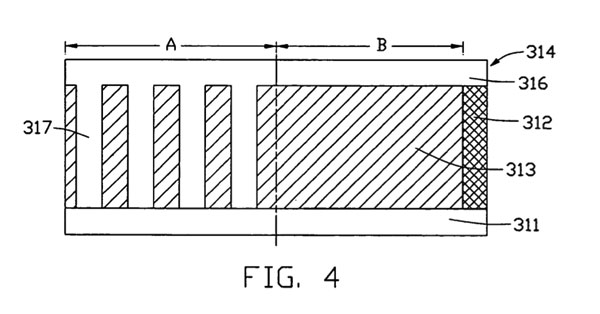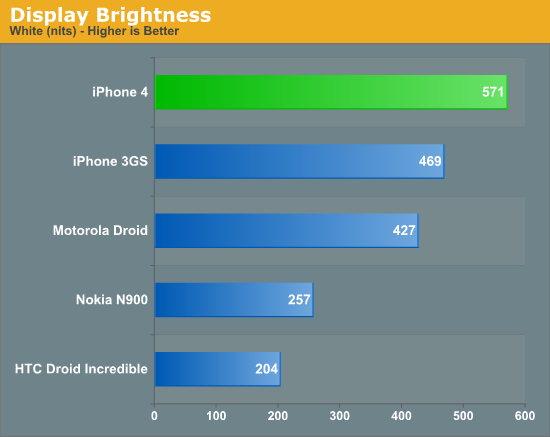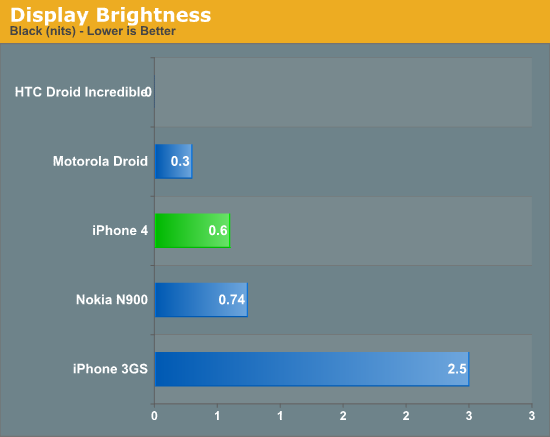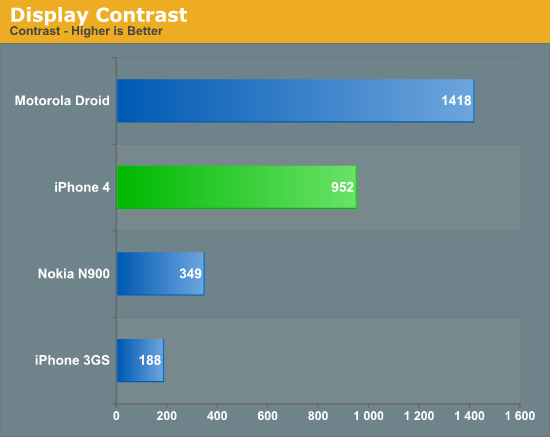Apple's iPhone 4: Thoroughly Reviewed
by Brian Klug & Anand Lal Shimpi on June 30, 2010 4:06 AM EST- Posted in
- Smartphones
- Apple
- iPhone 4
- Gadgets
- Mobile
More Display
It's obvious how Apple settled on 960x640; it's four times the resolution of the previous iPhones. However, instead of decreasing text size, iOS 4 scales appropriately, and the size of everything remains the same. The result is that there are small details everywhere that pop out. Apple's icons on the home screen are the first that really pop out, and new iOS 4 optimized applications will bring that increased detail as developers add higher resolution artwork.
The display panel itself uses a subset of IPS (In Plane Switching) display technology called Fringe Field Switching (FFS). Where IPS switches the crystal polarization in the plane of the display with two opposing electrical substrates composed of semi opaque metals (which decreases transmission and viewing angles), FFS uses considerably less metal by arranging the electrodes in a comb like structure.

See that - it almost looks like a comb. Or an impulse train. Or Dirac comb. So many combs.
The result is that there's considerably less metal in back and in front of the pixel, resulting in much higher transmission of light through the display, and higher brightness for a given backlight level. Using FFS to drive pixel switching is critical here because of the high dot pitch in the iPhone 4's display.
The other interesting difference between iPhone 4's retina display and previous displays is that the digitizer is in optical contact with the display itself. There's no longer an air gap, and as a result, no longer any opportunity for dust to gradually work its way inbetween. Over time, I've noticed a few dust specks creep in on my 3GS, it does happen. The digitizer and display panel are essentially laminated together. The added benefit is that fewer material interfaces results in fewer internal reflections - think the "super" in Super AMOLED but applied to TFT. That's what Apple has done here.
Apple is using Corning's Gorilla glass which touts hugely increased scratch resistance and robustness. Both the front and back of the iPhone 4 are that same type of glass. I've noticed a few superficial scratches (called sleeks) that have appeared on the back, but really the true test will be how the phone looks after 6 months in the pocket. It's interesting that the iPhone capacity markings have disappeared from the back of the phone - no doubt this was done so Apple could make one part and one part only for each color.
The rest of the details are in the specifications. Apple advertises increased brightness of 500 nits and a contrast ratio of 800:1. We measured, and our iPhone 4 exceeded specs at 571 nits and just under 1000:1 contrast ratio.



Note that the HTC EVO 4G is missing as Anand has it, but it's on its way to me. As soon as I get it, I'll measure display brightness, black point, and contrast and update these results. In addition, the HTC Droid Incredible (and thus Nexus One) contrast is effectively infinity by the way we calculate, due to pixels being completely turned off in the black state. In addition, I'm led to believe that the AMOLED's PenTile grid throws off our numbers when measuring brightness. I've run and rerun this test, it keeps coming up that way.
Next to the iPhone 4, the 3GS display really shows its age. It leaks light when displaying black, with an absurdly high black point of nearly 3 nits. Just looking at the lock screen on the iPhone 4 next to the 3GS it's readily apparent how much better blacks are. iPhone 4 easily bests the 3GS but still isn't quite as contrasty as the Incredible or Nexus One AMOLED displays, or the IPS in the Motorola Droid. You do get higher resolution and brightness, however, but nothing is free.
Going from the iPhone 4's display back to the 3GS is pretty painful, but going back to even relatively high dot pitch displays on the desktop is painful as well. Even on the "high resolution" MacBook Pro with 1680x1050 display, displaying an iPhone 4 screenshot at native resolution uses up 91% of the height. If there's one thing I hope the iPhone 4 display does, it's generate demand for 300 PPI level desktop displays - the era of 110 PPI displays being the norm needs to end now.










270 Comments
View All Comments
scarnie - Thursday, July 1, 2010 - link
See my article here: http://bit.ly/5pxjgkBasically, the iPhone 4 is about 33% faster than the 3GS (600MHz) and 25% slower than iPad (1GHz) putting it squarely at 800MHz.
Cheers,
Stu
heri16 - Thursday, July 1, 2010 - link
Since it has been confirmed that Apple would not be able to beat physics, the best way for them is to issue a firmware update to hide the signal loss in terms of bars (GASP!) . Since after-all, calls won't be dropped at one bar, why make us all worry?From my tests, attenuation by water-containing bodies is always a problem to RF. My best way around has been using micro-strip circular polarized antennas to reduce the effect. I've been using such antennas to cut 2.4Ghz signals through dense trees, which have "waterly" leaves. It also works better in rainy conditions compared to linear antennas.
(My tests shows reduction in attenuation by 70% in dbm units for my modded 2.4Ghz enterprise router through those same trees.) This will work since our hands/bodies are "waterly" too.
My suggestion to Apple to is have both thin circular-polarized micro-strip antennas embedded in the back surface, and linear polarized antennas at the sides, and diversity-RF controllers to get improved best-case and worst-case performance.
I'm not sure whether an iphone accessory maker can create the same fix through a paper-thin antenna plugged in.
heri16 - Thursday, July 1, 2010 - link
Here are some links to help understand the iphone RF fix.http://en.wikipedia.org/wiki/Circular_polarization
http://en.wikipedia.org/wiki/Microstrip_antenna
NordicNINE - Thursday, July 1, 2010 - link
I finished up work & school for the day and just popped down to relax. Brought up my favorite tech news site and started the recorded DVR shows. I pulled up this article and then the recording of the new Futurama started up.Xeeros - Friday, July 2, 2010 - link
Not to nitpick but The Incredible has 8GB internal PLUS the microSD which Verizon gives you a 2GB stick so it would be 10GB stock as they now package the SD card in the phone. Had a Launch unit and the refresher that says Droid on the box versuses the HTC incredible box. ONly difference was my store gave me a card for the 2GB and now its pre-packaged. To be honest most review sites that have it listed in comparison have it labeled this way, so probably not your fault.sporadic - Friday, July 2, 2010 - link
A question though:When you ran your PDF download tests were you using any encryption or was this on an open network?
dhvanii - Friday, July 2, 2010 - link
This is a great article on i4 antenna and DL reception. I have a few questions.1. if you take 1.5 MHz channel bandwidth, then the lowest signal strength measurable should be around -112 dBm. But this WCDMA and so if it is 4.5 MHz the lowest RSSI should be -107 dBm. Add to that a 4-6 dB noise figure and the lowest RSSI should be around -100 dBm. How is the device reporting -113 dBm for 3G ? Is that only for GSM reception where it is 200 KHz channel bandwidth and so theoretical lowest is around -120 dBm ?
2. How about UL ? What is the Max Tx Power of this device ? 23 dBm ? How is that affected by this antenna glitch. Radio link protocols requiring UL acks for DL packets will definitely get affected by this poor antenna performance if UL is also affected.
Thanks again for your detailed analysis.
navderek - Friday, July 2, 2010 - link
Well I'm glad we agree...to be honest I did not read the entire article, but only the section about the antenna issues with the handset.I did not see you bring up the point of CQI, nor did I see you mention that RSSI is really not a good measure for network coverage / quality (when used alone). Perhaps you've mentioned it in other articles, and if so a link to those would have been warranted for charities sake.
Have you ever considered writing up an article about how the air interface works? I think everyone would be much further ahead if they had a good basic understanding of the air interface and how the handset communicates with the BTS...especially now with so many networks competing it would put a little more power into the consumers hands to judge the quality of the network rather than rely on their silly marketing adds and crappy signal strength bar displays.
Finally, you said that at -107dB the iPhone4 "deals just fine" with it. Do you have data to back that up? What kind of data rates were you getting? I'd be surprised if you could even hit 1MB/s.
Just so you know, I work for TELUS Mobility in Canada. We have the first TRUE "all IP" network running in North America. We launched back at the end of 2009 with a 3.5G network. In my area we use NSN equipment and in practical use you can easily get sustained data rates greater than 10MB/s (downlink, theoretical = 21MB/s). We are also talking latencies of less than 50ms and almost no jitter....how did we do this? Well we are the only company in North America to have built the network from the ground up using IP transport all the way to the radios. We have fiber going to every single tower which serves only this 1 network (we have 2 others to manage as well, PCS / iDEN). :-) I'm not trying to prop-up my company or anything, but just giving a hint as to why other carriers such as AT&T have so many problems with their "patchwork" network which still most likely uses legacy copper circuits multiplexed and converted into IP packets...this puts significant strain on the core to keep up with the demands.
If people understood the air interface protocols in a general and basic sense at least they could judge the quality of this part of the network and then focus on looking into the other parts...I just find it frustrating that most people who don't understand how it works tend to give the network a "basket" rating based on simple RSSI measurements which does not really give much insight except as to how much radiation your standing in.
zmslink - Friday, July 2, 2010 - link
So the net effect is that iPhone 4 drops fewer calls then the 3GS despite losing as much as 24dB when held "incorrectly," but does that signal loss affect battery life much?davidcjones - Friday, July 2, 2010 - link
It is amazing how someone can do such detailed research to get to the bottom of this!Thanks for your hard work. Of course, I am distressed that people are so inclined to run to the courts to file class action suits before they actually investigate the issue in detail...
David Jones
Jericho, VT